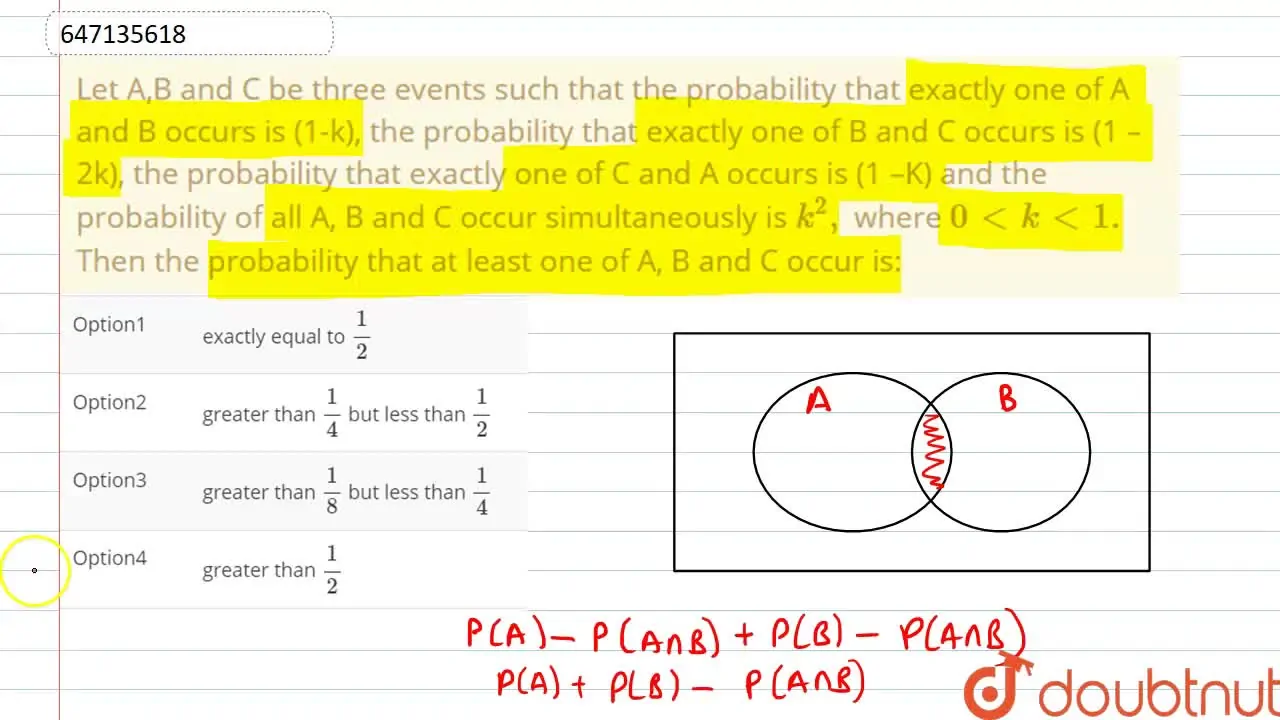Let A,B and C be three events such that the probability that exactly one of A and B occurs is (1-k), the probability that exactly one of B and C occurs is (1 –2k), the probability that exactly one of C and A occurs is (1 –K) and the probability of all A, B and C occur simultaneously is k2, where 0<k<1. Then the probability that at least one of A, B and C occur is:
exactly equal to 12
greater than 14 but less than 12
greater than 18 but less than 14
greater than 12
Step by step video & image solution for Let A,B and C be three events such that the probability that exactly one of A and B occurs is (1-k), the probability that exactly one of B and C occurs is (1 –2k), the probability that exactly one of C and A occurs is (1 –K) and the probability of all A, B and C occur simultaneously is k ^(2), where 0 lt k lt 1. Then the probability that at least one of A, B and C occur is: by Maths experts to help you in doubts & scoring excellent marks in Class 12 exams.
Related Playlists
- BOOK - JEE MAINS PREVIOUS YEARCHAPTER - JEE MAINS 2021EXERCISE - MATHEMATICS (SECTION-A)80videos
JEE MAINS 2021
- BOOK - JEE MAINS PREVIOUS YEARCHAPTER - JEE MAINS 2021EXERCISE - MATHEMATICS (SECTION-B)40videos
JEE MAINS 2021
- BOOK - JEE MAINS PREVIOUS YEARCHAPTER - JEE MAINS 2021EXERCISE - MATHEMATICS (SECTION -B)20videos
JEE MAINS 2021
- BOOK - JEE MAINS PREVIOUS YEARCHAPTER - JEE MAINS 2020EXERCISE - MATHEMATICS250videos
JEE MAINS 2020
- BOOK - JEE MAINS PREVIOUS YEARCHAPTER - JEE MAINS 2022EXERCISE - MATHEMATICS (SECTION - B)10videos
JEE MAINS 2022
Similar Questions
If A and B are two independent events, then the probability that only one of A and B occur is
View SolutionIf A and B are two events, then the probability that exactly one of them occurs, is given by
View SolutionIf A and B are any two events, the probability that exactly one of them occurs is
View SolutionIf M and N are any two events, then the probability that exactly one of them occurs is
View SolutionLet A and B be two events such that the probability that exactly one of them occurs is 15 and the probability that A or B occurs is 13 , then the probability of both of them occur together is :
View SolutionLet A and B two events such that the probgability that exactly one of them occurs is 25 and the probability that A or B occurs is 12, then probability of both of them occur together is :
View SolutionIf A and B are two events, the probability that exactly one of them occurs is given by
View SolutionIf A and B are two events, the probability that exactly one of them occurs is given by
View SolutionIf M and N are any two events, the probability that the exactly one of them occurs is
View SolutionIf M and N are any two events. The probability, that exactly one of them occurs, is :
View Solution


